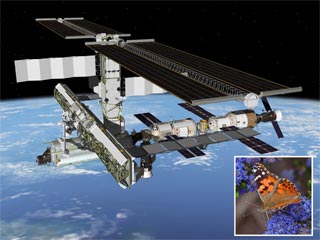The launch of Endeavor for mission STS-126, scheduled according to Israel time for early Saturday morning (02:55), will include, in addition to equipment and facilities to expand the living areas on the station, butterflies and spiders that school students in Denver will follow their development

The space shuttle Endeavor will launch into space tomorrow a payload prepared at the University of Colorado in Boulder, in which spiders spin spinning webs and impersonating butterflies and hundreds of elementary and high school students in the US will monitor them from the university's facilities immediately after the shuttle launch scheduled for Friday at 19:55 EST, or Saturday 02 :55 Israel time.
Both experiments were designed and built at the Center for Biological Technologies in Space of the University of Colorado - BioServe. The director of the center, Louis Stockdick, the main researcher of the project said that the intention is to compare the difference in the shape of the web that the spiders weave in space. The spiders will also get fed. The second experiment will follow the life cycle of butterflies in the low gravity of space - caterpillar to pupa to butterfly and again to egg - and compare this behavior with their counterparts who remained on Earth.
This will be the third time that an experiment has been uploaded as part of the Bioserve educational program, although biological experiments that are not for children have been uploaded by Bioserve on all shuttle missions since the early XNUMXs. The place where the Beuser center is located. “This program is a great example of using national assets like the International Space Station to inspire students in science, technology, engineering and math schools.
More than ten middle schools from Colorado will participate in the educational project, including public schools from Denver and St. Erin Valley, and they will be joined by students from several schools, said the director of the mission on behalf of Beuser, Stephanie Countryman.
The Bioserv experiment will transmit video, still images and data from the station to educational partners, including the Denver Museum of Science and Nature, the Butterfly Pavilion in Westminster, Colorado, and Baylor School of Medicine.
Baylor has provided students and teachers with guidance that includes lesson plans and classroom activities around the topic of butterflies and spiders, Countryman said. The teachers also underwent training at the Science and Nature Museum in Denver in collaboration with the Butterfly Pavilion in Westminster.
The purpose of the experiment is to follow a full life cycle of painted lady butterflies in a zero gravity environment in space and compare this with the conditions of raising a similar cycle in schools, said the country man. The limiting experiments in space and on Earth will begin with four-day-old larvae and will include supplying nectar to butterflies that hatch from the pupal stage and become adults.
The second goal is to test a spider's ability to weave webs that will capture food in the nearly blanketless environment of space and compare it to the performance of spiders of the same species on Earth, Countryman said. According to her, the spiders will eat live fruit flies and water to keep them alive during the experiment.
The spiders and butterflies will remain inside special boxes built by Bioserve at all times, and will be launched into space in a facility called CGBA, which is the size of a suitcase and which was used to launch previous Bioserve experiments into space in the early XNUMXs.
Bioserve experiments will now be uploaded to every shuttle that will take off into space until the shuttles are shut down in 2010. Bioserve is a non-profit funded by NASA and operates out of the university whose goal when it was founded in 1987 and still today is to improve products through research in the field of life sciences in space in collaboration with industry, academia and the government. Since 1991, Bioserv has uploaded payloads to 29 shuttle missions, some of which even went to the Russian Mir space station and then to the International Space Station.
